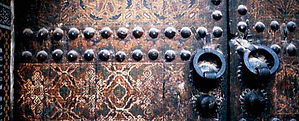
Weathering Research for Mosque Design
Most mosques in America today arrive as if they were plucked from their motherland. They come preserved with shrink wrap that protects them from any type of “soilents,” including both cultural and physical. It is this shrink wrap that I intend to unpack in my junior year designs.
Mosques have a rich history of over 1400 years and during that time, the buildings have endured the elements and overcome decaded of hardships. Buildings cannot stay in pristine, shrink wrapped condition forever; they have to face constant scuffing. Rather than making them dirty, weathering makes them beautiful.

Abrasion
Abrasion occurs when a material breaks down through direct contact with atmospheric conditions, such as heat, water, ice and pressure, but without chemical weathering. Usually abrasion leads to other types of weathering, such as making foot holes for plants to grow, or textured surfaces for stains to cling to.
Biological Weathering
Algae, Lichens, and Moss can grow on surfaces that are frequently wet or damp. Lichens trap water on the surface, which can assist in other forms of weathering. These smaller plants can also crack the surface, which allows larger plants to grow in the cracks. Algae, lichens, and moss are easiest to grow on the North (wetter side) of a building, or under other plants’ overhangs.

Runoff Stains
When it rains, the water picks up tiny particles of dirt, minerals, bacteria, and gaseous pollutants from the air. When the water evaporates or runs down a surface slowly, it drops off these particles, leaving a stain. Over time the stain becomes larger and more noticeable. Staining is accentuated by large surfaces, horizontal ribs, horizontal or sloped vertical surfaces, heavy sculpturing, and smooth textures.

Lime Run
Lime run is a specific case of hard water staining. When calcium carbonate deposits are left on the surface from rain (or when they are leeched out of the mortar) it leaves a white streaky stain that is permanent and hard to remove.

Metal Stains
Metal staining can either be caused by pulverized metals within the brick or by the metal accents on the exterior of the building and brick. The metals become oxidized by becoming exposed to oxygen in the air or in water. When the metal reacts with the oxygen, it typically changes colors and deteriorates, leaving stains that are carried by water down the face of the building.


Higher humidity = more biological weathering

More sun = more weathering

More sun = more weathering

More rain = more weathering

Stronger wind = more weathering

Greater difference = more weathering